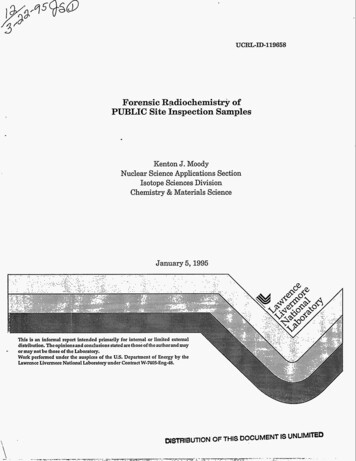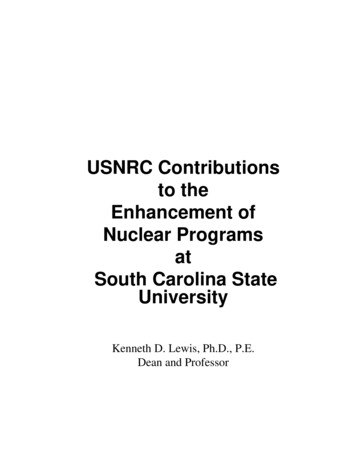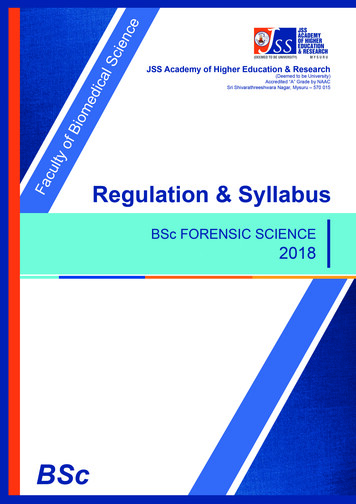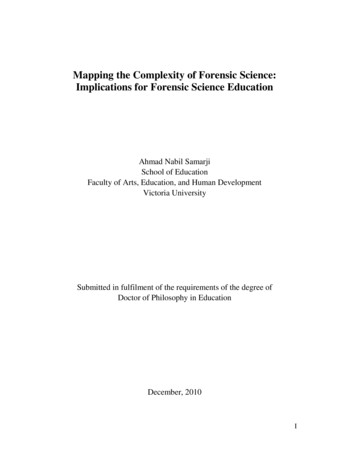
Transcription
UCRLID-119658Forensic Radiochemistry ofPUBLIC Site Inspection SamplesKenton J. MoodyNuclear Science Applications SectionIsotope Sciences DivisionChemistry & Materials ScienceJanuary 5,1995. . . . . . . . . . . .-. . . . .This is an informal report intended primarily for intemal or limited externaldistribution. Theopinionsand conclusionsstatedarethoseof theauthorandmayor may not be those of the Laboratory.Work performed under the auspices of the U.S. Department of Energy by theLawrence LivermoreNational Laboratory under ContractW-7405-Eng-48. .\
DISCLAIMERThis document was prepared as an account of work sponsored by an agency ofthe United States Government. Neither the United States Government nor theUniversity of California nor any of their em loyees, makes any warranty,express or implied, or assumes any legal lia ility or responsibility for theaccuracy, completeness, or usefulness of any information, apparatus, product,or process disclosed, or represents that its use would not infringe privatelyowned rights. Reference herein to any specific commercial roducts, rocess,or service by trade name, trademark, manufacturer, or ot erwise, oes notnecessarily constitute or imply its endorsement, recommendation, or favoringby the United States Government or the University of California. The viewsand opinions of authors ex ressed herein do not necessaril state or reflectthose of the United States overnment or the University o California, andshall not be used for advertising or product endorsement purposes.ER8YThis re ort has been reproduceddirectly rom the best available copy.PAvailable to DOE and DOE contractors from theOffice of Scientific and Technical InformationP.O. Box 62, Oak Rid e, TN 37831Prices available from 615) 576-8401PAvailable to the ublic from theNational Technical nformation ServiceU.S. De artment of Commerce52i.5 Port Ro a1 Rd.,Springfield,22161dlB
DISCLAIMERPortions of this document may be illegiblein electronic image products. Images areproduced from the best available originaldocument.I
Forensic Radiochemistryof PUBLJC Site Inspection samplesKenton J. MoodyIsotope Sciences DivisionLawrence Livermore National LaboratoryLivermore, CA 94551INTRODUCTIOT\/For the past two years, the Isotope Sciences Division (formerly NuclearChemistry) has been developing a program t o extract forensic information fromsamples of plutonium o r highly-enriched uranium. In the case of Pu, it ispossible to determine the date of chemical separation, the date of its casting asmetal, the enrichment of the uranium starting material, the length and perhapsother details (neutron spectrum and fluence) of reactor irradiation, thereprocessing technique, and clues to the identity of a specific facility. Forenriched uranium, information is possible on the detailed timeline of materialproduction, including the date of enrichment, whether the plant feed wasformerly-irradiated uranium, the date of final purification; and facility-specificclues. For more information, see "Dissolved Oralloy Standards and the Origin ofHEXJ", by Ken Moody, LLNL report UCRLID-117611, April 13,1994.It would be valuable t o be able t o apply the same techniques t o materials ofopportunity associated with clandestine or illicit nuclear weapons production.However, interpretation of the radionuclide contents of dilute samples containingsmall or finely-divided amounts of Pu and U is more complicated than a similaranalysis of a bulk sample; the isotopics of the sample,may be associated more withthe plant waste stream than with product, and chemical effects of theenvironment after dispersal of the sample alter its properties. Nevertheless, itwas decided to analyze interesting samples associated with the U S . weaponsproduction facilities and determine how much forensic information wascontained therein. In support of this endeavor, samples from the recent PUBLICsite inspections of two uranium enrichment facilities were obtained.It is possible that the U.S. gaseous diffusion facilities at Portsmouth, OH andPaducah, KY will be subject to international inspections for safeguards andaccountability purposes. The question arose whether an inspector with a covertagenda could surreptitiously learn classified information from the analysis ofprocess debris found at these sites. To explore that possibility, the LLNL ForensicScience Center (FSC) was asked t o undertake "counter-forensic" sampling inorder to evaluate the potential magnitude of the risk to classified technology.Proj e c t PUBLIC (Portsmouth/Paducah Uranium Barrier : Livermo r eInvestigative Campaign) was designed t o apply state-of-the-art analyticaltechnologies t o interrogate wipes and other samples from areas of the plantswhere converters were disassembled or barrier was destroyed.
While the radiochemical analysis given in this report does not relate directly tothe original purpose of PUBLIC, collateral radioanalytical chemistry providesbackground information about the activities at the plants and the time scale of theoperations. Such knowledge could prove valuable in placing deductions about thediffision barrier within a context that might support the conclusions that aredrawn. As a result, this work also appears as a chapter in the final (classified)PUBLIC report ("Project PUBLIC: Counter-forensic Investigation of U.S. GaseousDiffusion Plants", E. Randich et a1.,1995; in process).SAMPLE SELECTIONWhile the PUBLIC inspection team had no prior knowledge of the classifiedaspects of the diffusion barrier, they did have the unclassified information thatthe barrier material was formed by sintering a nickel powder. Thus, whileseveral samples were collected by scraping loose debris into plastic bottles withspatulas, o r by wiping interesting surfaces with moist filter paper, most of thesamples were collected magnetically. The team concentrated o n collectingspecimens from confined or sheltered areas where debris could have collectedover a period of years.A total of approximately forty samples were collected in the two site inspections.These samples were returned t o LLNL where they were subjected t o an initialprescreening (including a radiation survey, an X-ray fluorescence measurement,and examination under an optical microscope) t o identify potential barriermaterials. Samples containing significant amounts of nickel were divided intotwo or more subsamples by segregating dissimilar debris components.The radiochemical analyses are labor-intensive; it was therefore impossible toeven consider treating most of the 69 samples generated by PUBLIC.Furthermore, the analyses are destructive, resulting in the total consumption ofthe selected samples. Consequently, it was decided that no more than fivesamples would be radiochemically analyzed, and that only one of these sampleswould be a "pure" Ni specimen selected as candidate diffusion barrier material.The chosen samples would have fairly high radioactivity contents, as measuredby initial sample prescreening. With these considerations, the specimens listedin Table 1were selected.
Table 1. Samples Selected for Radiochemical Analyses, Portsmouth and PaducahSite Inspections.e a m d e I.D,94-7-14 (PO-7)Weight7.0 g94-7-17 (PO-9)1.4 g947-19 (PO-11)3.3 g94-7-38 (PK-4)4.9 g94-7-45 (PK-7)20.5 gBlank (X)4.7 gDescnDtionNi flakes collected with a spatulainto a polyvial; from Building X-705catwalk; Portsmouth.Magnetic flakes, both rust and Ni,collected from the top of an I-beamapproximately 10 feet from the floor;Building X-705, basement cutting area,east wall; Portsmouth.Magnetic grit, mostly Fe, collectedfrom groove in floor around railroadtracks; Building X-705; Portsmouth.Loose debris, perhaps some Niflakes, collected with spatula frombracket on support E8, approximately15 ft from floor; Building C-400;Paducah.Magnetic grit, with most of the Niremoved, collected along concrete/transite interface, about 8 feet fromfloor; radioactive waste area, BuildingC-400; Paducah.Radiochemistry blank constructed from2.93 g Fe203 1.73 g Ni203.xH20(77.0%Ni) 0.055 g CaO.Sample 94-7-14 was very rich in candidate barrier material, and was the source of94-7-15, which was extensively analyzed and is described in detail in the PUBLICreport. The Blank sample was constructed to check for cross contaminationamong the samples during the analyses; it was treated with the same reagents atthe same time as the other samples, and should return completely negativeresults for radionuclide content. AMPLE DISSOLUTION AND XRF RESULTSAs the first step, a sample must be totally dissolved. The dissolution must becomplete t o avoid fractionating the elements from one another (which can resultin improper age determinations) and t o yield a uniform sample that can bequantitatively analyzed for gamma-ray emission and by XRF. As anticipated, thedissolution of samples containing nickel, iron, dirt, paint flakes, plastic shards,oil, broken glass, hair, and (in one case) a dead insect, can be formidable. Thefollowing procedure was used on the PUBLIC samples:
--The samples were poured into Erlenmeyer "reaction" flasks, and the originalsample containers were sequentially washed with water and with 8M HNO, toensure quantitative transfer. Samples were heated gently until reaction wascomplete. A few drops of 9M HCl were added t o each reaction flask, and thesamples were gently evaporated t o moist residues. Several times over the next fewdays, 9M HCl was added to the samples, which were then evaporated to moistresidues. 4M HC1 was added to each sample, and the supernatant solutions werefiltered through Whatman #42 paper into fresh Erlenmeyer flasks which were toserve as primary containers for the analytical solutions. Several times over thenext two days, 8M HNO, was added to the residues in the reaction flasks, whichwere evaporated to moist deposits. Next, 2 ml of 7.5M HC10, and several ml of 8MHNO, were added to each flask, and the resultant mixtures were evaporated untilthe evolution of perchloric fumes was observed. 4M HC1 was added t o thesamples, and the supernatant solutions were filtered into the Erlenmeyerprimary containers. Several ml of 8M HNO, and 1 ml of conc HF were added tothe residues in the reaction flasks, which were then evaporated to moist deposits.Three ml of 7.5M HClO, were then added to each reaction flask, and the sampleswere evaporated through perchloric fumes to dryness. The reaction flasks werethen heated vigorously with a Bunsen burner to volatilize SiF,. Several ml of 4MHC1 were added to each flask, and the resultant solutions were filtered into theErlenmeyer pots. The filter papers were washed with 4M HC1, and were removedfrom the funnels and placed into the appropriate reaction flasks. Several ml of8M HNO, and 2 ml of 7.5M HClO, were added t o each flask and the samples wereheated until the filter papers were destroyed with the evolution of copiousperchloric fumes. The contents of the flasks were quantitatively transferred tocentrifbge cones with 4M HCl, the solutions were centrifuged, and the supernatescarefidly decanted into the primary containers.Four of the six samples were completely dissolved, but several milligrams ofintractable white powder remained of samples 94-7-38and 94-7-45(the twoPaducah specimens). XRF showed that this material was mostly titanium, withsome minor zirconium, and was therefore probably residual paint chips. It wasdecided t o treat these residues separately from the bulk samples, under theassumption that only a small fraction of the total radionuclide content wasentrained in the precipitates. The residues were transferred to Ni crucibles witha minimum amount of dilute HC1 and were evaporated t o dryness. Several gramsof NaOH and 1gram of Na202 were added to the crucibles, which were heated tomelt the mixtures. Twenty ml of water were added to the molten samples; aftercooling, volumes were doubled with 9M HC1 and the supernatant liquids weretransferred t o fresh Erlenmeyer flasks. Several ml of 4M HC1 were added to theresidues in the crucibles; after heating for several minutes, the supernates weredecanted into the flasks containing the previous solutions. The residues wereand 4 ml of conc H2S04 were added t o eachheated to dryness, 0.5 g of (NH4)2S04crucible, and the mixtures were heated for several hours. The resulting solutionswere diluted with 4M HC1 and transferred quantitatively to the flasks containingthe previous supernates. Only a trivial amount of residue was left in the- 4 -
crucibles. The titanium solutions were analyzed with an abbreviated version ofthe analytical procedure given below, and were found to contain less than 1%ofthe Th, U, Np, and Pu determined in the main samples. Analytical results givenin Table 5 (see below) for samples 94-7-38 and 94-7-45 have been corrected for theselosses.The final analytical working solutions are described in Table 2. Aliquots of 60microliters of each solution were dried on 1-inch diameter Whatman #541 filterpapers and subjected to XRF analysis. The results for major constituents, scaledto the total solution volume, are also given in Table 2. In many cases, the sum ofthe measured masses of these constituents is significantly lower than that of theoriginal sample; the reason is that XRF is insensitive to low-Z materials like C,Al, and Si, particularly in the presence of significant amounts of C1 from thesolvent. In the case of the Blank, however a direct comparison of the measuredXRF values with the known materials input gave good agreement (1940 mg Femeasured by XRF vs. 2050 mg added, and 1240 mg Ni measured vs. 1330 added).The explanation for the minor amounts of Cu and Zn measured in the blank istheir presence as contaminants in the reagent compounds used for solutionsynthesis.Table 2. Description of Dissolved Samples and XRF results. XRF uncertainties. .are rt 10%.Samde I.D,94-7-1494-7-17Total Volume70 ml75 mlColorgreenyellow94-7-19100 mlorange-t an94-7-38150 mlorange94-7-45215 ddark brownBlank75 mloliveXRF Composition6550 mg Ni, 6 mg Cu.725 mg Fe, 225 mg Ni,4 mg Cu, 3 mg Zn, 6 mg U.2220 mg Fey145 mg Ni,68 mg Cu, 8 mg Zn,4 mg Pb, 14 mg U.1500 mg Fe, 108 mg Ni,13 mg Cu, 75 mg Zn,16 mg Pb, 32 mg U.8600 mg Fey1680 mg Ni,204 mg Cu, 337 mg Zn,9 mg Pb, 183 mg U.1940 mg Fe, 1240 mg Ni,7 mg Cu, 1mg Zn.
ALIQUOTING AND TRACINGAliquots of each working solution were taken for different aspects of theradiochemical analyses. The 60-microliter aliquots for XRF analysis wereindicated above, and other aliquots are listed in Table 3. Gamma-spectrometryaliquots were transferred t o plastic counting vials and sealed in Saran wrap.This is a standard counting geometry for LLNL's Isotope Sciences countingfacility. All other samples were delivered into 40-ml centrifuge cones.Unspiked samples were not traced with radionuclides. To "Spike Mix P"solutions were added standard aliquots containing about 175 dpm 236Pu, 30 dpm232U(with 228Th and daughters in equilibrium), and 440 dpm 243Am(with 239Npin equilibrium). To "Spike Mix N" solutions were added standard aliquotscontaining about 44 dpm 243Amand 820 dpm 237Np (with 233Pa in equilibrium).Comparison of measurements of both spiked and unspiked samples results inchemical yield determinations and quantitative, abselute data for radionuclideatoms per ml of original solution.Table 3. Aliquot information for radiochemical analysis.Sample Snec25 ml25 ml25 ml25 ml25 ml25 mlUnsniked15 ml20 ml20 ml25 ml30 ml20 mlSpike Mix P10 ml10 ml20 ml25 ml25 ml10 mlSpike Mix N10 ml10 ml20 ml25 ml25 ml10 mlGAMMA-SPECTROMETRY RESULTSThe gamma-spec aliquots were counted with large-volume germanium detectorsfor emitted photons having energies between 50-2000 keV. Each data-acquisitionperiod was between 3 and 6 days in length. Using detector calibrationparameters, gamma-ray peaks were identified with the proper energies and werecorrected for detector efficiency to yield resultant photon intensities. The only238U,andradionuclides detected in the samples with this technique were 235U,237Np. The number of atoms thus determined in each gamma-spec sample arelisted in Table 4.It was somewhat surprising that the 237Np contamination level was so high,particularly in the Paducah samples, where the radioactivity due to decaying237Np was comparable t o that from uranium. From the radionuclide assay of theBlank specimen, no significant cross contamination among the samples wasevident. The uranium measurements allow the calculation of enrichment- 6 -
values, given in the last column of Table 4. All of the Portsmouth samples aresomewhat higher in 235Uthan is natural uranium (0.71%), while both thePaducah samples are depleted in 235U.The gamma-spec results are presented here separately, instead of combined withthe more precise results of the radioanalytical chemistry procedure describedbelow, for two reasons: (1)The results were available before chemical processingwas begun and were the first clear indication that procedures developed for themeasurement of tracer-level actinide nuclides would need modification t oaccommodate the multi-milligram quantities of uranium present i n theanalytical samples; and (2) the data presented in Table 4 also give an indication ofthe limitations of the precision of radionuclide determinations via non-destructivegamma-ray spectrometry.Table 4. Results of Gamma-Spec Analysis of Working Solution BlankU-238 atoms(9.05&2.00)E17(5.39k0.79)E 18(1.10&0.14)E19(1.81&0.23)E19(6.92 0.80)E19- 4E16U-235 atoms(1.75 0.07)E16(5.35&0.13)E16(3.67 0.06)E17(5.50&0.18)E16(2.46 0.05)E17 5E14ND-237atoms(1.29&0.27)E13(3.07&0.48)E13 9El2(1.3GO.O2)E15(2.99 0.04)E15- 9El2U-235 enrich,(1.90&0.43)%(0.98&0.15)%(3.23kO.4 l)%(0.30&0.04)%(0.35&0.04)%--RADIOANALYTICAL FORENSIC PROCEDURESThe analytical samples described in Table 3 were evaporated t o dryness. Eachsample was then dissolved in 9M HCl and evaporated t o dryness again t o expelresidual HNO,. Each sample was dissolved in 9M HC1 with 0.5 ml of conc HI andevaporated t o dryness, then was dissolved in 9M HC1 with 0.5 ml of conc HNO,and evaporated to dryness. This step was then repeated; the oxidation/ reductioncycle ensures that any added radiotracers are equilibrated with the sample.Each sample was dissolved with 6M HC1, and Fe3 was extracted into hexone.The hexone was then back-extracted with 6M HC1. These steps were repeatedwith fresh hexone until the organic phase became colorless, indicating little ironwas left in the sample. The 6M HC1 washes were recycled t o the appropriatesamples.To each fraction were added 2 drops of 10 mg/ml Fe3 carrier, 1drop of 10 m g / dLa3 camcr, and 1drop of 10 mg/ml A13 camer. The samples were evaporatedto dryness and dissolved in minimum volumes of IM HC1. The solution volumeswere then doubled by the addition of conc NH40H, and the samples were digestedovernight in a warm-water bath. After centrifugation, the supernatant liquidswere decanted to waste, the precipitates were contacted with water, and 1ml of- 7 -
conc NH,OH was added t o each. After digesting for an hour, the samples werecentrifuged, and the supernatant liquids were decanted to waste. The hydroxideprecipitates were dissolved in a minimum volume of 9M HC1, the solutionvolumes were doubled with addition of conc HCl, a few drops of 8M HNO, wereadded to each sample, and the solutions (absent most of the original Fe, Ni andCu) were stored until needed.The analytical solutions were loaded onto Dowex-1x8 anion exchange columns, 1cm in diameter by 10 cm long, and the eluents were collected as An fractions.Subsequent column washes with 9M HC1 were combined into these An fractions.Plutonium (Pu) was then eluted from the columns with a warm solutioncomposed of 1part by volume of conc HI to 12 parts of 10M HC1. Protactinium (Pa)was then eluted with a solution of composition 9M in HC1 and 0.02M in HF.Neptunium (Np) was eluted next with a solution that was 4M in HC1 and 0.1 M inHF. Finally, uranium (U) was eluted with 0.5M HC1. All of the fractions wereevaporated to dryness prior to further processing.Np fractions (from Spike Mix P samples only) were dissolved in 10M HC1 with adrop of nitric acid, heated gently, and loaded onto 4-mm-diameter Dowex-1x8anion-exchange columns. The resin beds were washed with 10M HC1, then with8M HNO, (until color from transition metals was gone), then with 9M HCl.Residual Pu was then removed by washing the column with a warm solution of 1part conc HI and 12 parts 10M HC1, followed by Pa removal with a solution 9M inHC1 and 0.02M in HF. Np was then eluted with a solution 4M in HC1 and 0.1M inHF. The Np fractions were evaporated to dryness, dissolved in 8M HNO,, andloaded on 2.5-mm-diameter Dowex-1x8 columns, which were washed sequentiallywith solutions of 8M HNO,, 9M HC1, and warm 1-to-12 conc HI/lOM HCl. Onceagain, Np was eluted with a solution 4M in HC1 and O.1M in HF, and the Npfractions were evaporated to dryness. The Np fractions were dissolved in 8MHNO, and loaded onto 2.5-mm-diameter Dowex-1x8 columns, which were washedsequentially with 8M HNO, and 9M HC1. Np was eluted with 0.5M HC1, and thesolutions were evaporated t o dryness.Pa fractions '(from Spike Mix N samples only) were dissolved in 8M HNO, andwere loaded onto 6-mm-diameter Dowex-1x8 anion-exchange columns. The resinbeds were washed with 8M HNO, (until color from transition metals was gone),then with 9M HC1. Pa was eluted with a solution 9M in HCl and 0.02M in HF.The Pa fractions were evaporated to dryness, dissolved in 8M HNO,, and loadedonto 2.5-mm-diameter Dowex-1x8 columns, which were then sequentially washedwith 8M HNO,, 9M HC1, and warm 1-to-12 conc HUlOM HC1. Pa was then elutedwith 9M HCVO.02M HF, after which the fractions were evaporated to dryness.U fractions (from Spike Mix P and Unspiked samples only) were dissolved in 8MHNO, and were loaded onto 4-mm-diameter Dowex-1x8 anion-exchange columns.The resin beds were washed with a small volume of 8M HNO,, then with 9M HC1.- 8 -
Residual Pu was removed by washing the column with a warm solution of 1partconc HI and 12 parts 10M HC1, followed by residual Pa and Np removal with asolution 4M in HC1 and 0.1M in HF. U fractions were eluted with 0.5M HC1, andwere then evaporated to dryness. The U fractions were dissolved in 8M HNO, andwere loaded onto 4-mm-diameter Dowex-1x8 columns, which were thensequentially washed with 8M HNO,, 9M HCl, and 4M HCVO.1M HI?, after whichthe U fractions were eluted with 0.5M HC1 and evaporated to dryness. U fractionswere then dissolved in 8M HNO, and were loaded onto 4-mm-diameter Dowex-1x8columns, which were then washed with 8M HNO, and with 9M HC1. Final Ufractions were then eluted with 0.5M HC1 and evaporated to dryness.Pu fractions (from all analytical samples) were dissolved in 8M HNO,. To eachfraction was added a drop of saturated NH4N02; the samples were heated briefly,then loaded onto 4-mm-diameter Dowex-1x8 anion-exchange columns. The resinbeds were washed with 8M HNO,, then with 9M HC1, after which Pu fractionswere eluted with a warm solution of 1part conc HI and 12 parts 10M HC1. The Pufractions were evaporated t o dryness, dissolved in warm 8M HNO, with a drop ofsaturated NH4N02, and the previous ion-exchange step was repeated using a 2.5mm-diameter Dowex-1x8 column. The resultant Pu fractions were evaporated todryness, dissolved in warm 8M HNO, (NH4N02), and loaded onto 2.5-mmdiameter Dowex-1x8 columns, which were washed sequentially with copious 8MHNO, (final U decontamination) and 9M HC1. Final Pu fractions were theneluted with 0.5M HC1 and evaporated to dryness.-.An fractions (from all analytical samples) were dissolved in 8M HNO,. To eachfraction was added a drop of saturated NH4N02; the samples were heated briefly,then loaded onto 6-mm-diameter Dowex-1x8 anion-exchange columns. The resinbeds were washed with 8M HNO,; the load and wash solutions were collected asAn fractions (containing Am, Ac, and Ra). Thorium (Th) fractions were theneluted from the columns with 9M HC1 and evaporated t o dryness (see below). Anfractions were evaporated t o dryness several times with addition of 9M HC1 (toremove nitrate ion), after which they were dissolved in water and loaded onto 6mm-diameter Dowex-50x4 cation-exchange columns. It often took several wateradditions followed by column loadings t o completely dissolve the samples. Theresin beds were then washed with copious 0.5M HC1 and then with 1M HC1, afterwhich An fractions were eluted with 9M HCl. The An fractions were evaporatedt o dryness, dissolved in water, and loaded onto 4-mm-diameter Dowex-50x4columns, which were washed sequentially with 0.5M HCl, 1M HC1, and 2M HC1.At the first indication of 241Am alpha activity in the 2M HC1 eluents, An fractionswere eluted with 6M HC1. After the An fractions were evaporated to dryness, thelast step was repeated with 2.5-mm-diameter Dowex-50x4 columns. The resultantAn fractions were evaporated to dryness. An fractions derived from the Spike MixP samples were further processed as follows: The fractions were dissolved insaturated (nominally 13M) HC1 and loaded onto 2.5-mm-diameter AG MP-50cation-exchange columns. Americium (Am), radium (Ra), and- 9 -
lanthanudactinium (Ac) fractions were sequentially eluted from the columnswith saturated HC1, and were evaporated to dryness.Th fractions (from A n fractions derived from Spike Mix P and Unspiked samples)were dissolved in 8M HNO,. To each sample was added a drop of saturatedNH,NO,; the samples were heated briefly and then loaded onto 4-mm-diameterDowex-1x8 anion-exchange columns. After column washes with 8M HNO,, Thfractions were eluted with 9M HC1. The Th fractions were evaporated to dryness,dissolved in 8M HNO,, and loaded onto 2.5-mm-diameter Dowex-1x8 columns,which were then washed with 8M HNO,. Th fractions were eluted with 9M HC1and evaporated t o dryness. The previous ion-exchange step was repeated, and thefinal Th fractions were evaporated to dryness.Ra fractions from samples 94-7-38 and 94-7-45 containedas determined byalpha spectroscopy (see below). Unfortunately, the chemical yield as determinedfrom short-lived 224Ra i n the Spike Mix P samples was not valid; earlyprecipitation steps, that may have had poor efficiencies for Ra resulted inintermediate samples containing high yields of the 228Th precursor nuclide,which would have caused 224Ra t o grow back into the samples. For the twosamples with indications of Ra, special analytical samples were constructed from15 ml of working solution and three times the standard P Mix aliquot. After asingle oxidationheduction cycle and several hexone extractions (described above),the samples were evaporated t o dryness, dissolved in. 9M HC1, and loaded on 8mm-diameter Dowex-1x8 anion exchange columns, which were then washedwith more 9M HC1. The load and wash solutions were collected as Ra fractions,evaporated t o dryness several times with the addition of HNO,, and were thendissolved in 8M HNO,. These solutions were loaded onto 4-mm-diameter Dowex1x8 columns, which were then washed with more 8M HNO, (this is the TWRaseparation time). The load and wash solutions were collected as the Ra fractions,and evaporated to dryness several times with the addition of 6M HCl. The Rafractions were then treated to the same cation-exchange procedure outlined abovefor the An fractions, including the AG MP-50 step. Final Ra fractions wereevaporated t o dryness.Final Ra, Ac, Th, Pa, Np, and Am samples were dissolved in minimum volumesof 6M HC1 and transferred t o tungsten filaments where they were re-evaporated.Counting samples were prepared by volatilizing the samples onto 1-inch diameterplatinum disks through the rapid heating of the filaments. U fractions weresubdivided into several samples of different strengths; some of these werevolatilized onto platinum, while others were subjected t o isotopic analysis byinductively-coupled-plasma mass spectrometry (ICP-MS). Pu fractions fromSpike Mix P and Spike Mix N samples were volatilized onto platinum, as were allUnspiked fractions except those from samples 94-7-38 and 94-7-45, which wereanalyzed for isotopic composition by thermal-ionization mass spectrometry(TIMS).-10-
Np and Pa samples were mounted in standard-geometry gamma-spec holdersand were counted close to the faces of large-volume germanium photon detectors;gamma-ray intensities were used to measure the activities of the 239Npand 233Pachemical-yield indicators. Gross alpha-decay rates of these samples weremeasured with calibrated 2-pi gas-proportional counters in order to complete thelink to chemical yields. All Pt-backed samples were pulse-height analyzed foralpha particle emission with surface-barrier or Frisch-grid gas-filled detectors.In total, more than 130 samples were generated and counted in the course of theseradioanalytical analyses.RADIOANALYTICAL RESULTSResults of the analyses of the six WOI ing solutions are given in Table 5, scaled tothe masses of the original samples. These data are derived from a combination ofalpha-particle, gamma-ray, and mass spectrometry analyses. Data are given inatoms, except for 239Pu and 240Pufor those samples where Pu fractions were notsubjected t o mass-spectrometric analysis. Since 239Pu and 240Pu are notresolvable with alpha spectroscopy (due t o their similar alpha-decay energies), thesum of their activities (in disintegrations/minute) is given i n the Table.Assessments of 239Pucontent are derived -from 240Pu/239Pumass ratios estimatedfrom 238Pu/(239Pu 240Pu)activity ratios (see below). Values listed for 233Uarecalculated from the 234U content and the relative amounts of their decaydaughters (229Th and 230Th,respectively); as will be seen below, this may not bean unambiguous calculation.The distribution of uranium isotopes in each sample is given in Table 6 in theform of atom ratios t o 238Ucontent
Forensic Radiochemistry of PUBLJC Site Inspection samples Kenton J. Moody Isotope Sciences Division Lawrence Livermore National Laboratory Livermore, CA 94551 INTRODUCTIOT\/ For the past two years, the Isotope Sciences Division (formerly Nuclear Chemistry) has been developing a program to extract forensic information from samples of plutonium or highly-enriched uranium.










